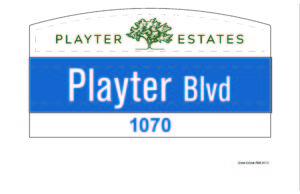GREAT and HAPPY NEWS to share with PARA members!
We have received approval from the City of Toronto for the design for our unique, designated street signs, unveiled here in its final format to you.

Given the pandemic, it’s not clear when the signs will be installed. We have already negotiated the sign placements with our local BIA and have done some fundraising for this initiative. Many neighbours have contributed to this in so many ways and it’s heartening to see such community spirit in action.
Special thanks go to Marian Walsh and Art Mandalas who carried this project to completion with the City. Art and his team are responsible for the design.
For a more detailed description of why we selected the butternut tree as our community logo, please see the Addendum below.
This street sign project is part of the ongoing 5-item plan detailed in our earlier report on the PARA website under Beautification Committee (September, 2018).
We continue to work on the entry feature and landscaping elements to be installed at the TPA parking lot at the historic entry to Playter Estates (corner of Danforth and Playter Blvd). With the pandemic, the TPA has encountered some negative budgetary effects that preclude it from undertaking this project with us for now. We are optimistic this will proceed in the future. We have continued to work on this achieving an approved design as well as the support of the local BIA and our councillor, Paula Fletcher.
In an ongoing way, we welcome donations towards these many positive things which will celebrate our important history and improve our neighbourhood. Please consider a donation via the PARA website and indicate it is intended to support Beautification projects.
Addendum to February, 2021 Beautification Committee Report
Our Natural History: The Butternut Tree
The natural landscape in this region included native butternut trees. These were plentiful in the Don River valley and groves of the trees covered the original Playter farmlands, the land upon which our neighbourhood now exists. The butternut tree is a noteworthy part of our natural history.
Elizabeth Simcoe, wife of John Graves Simcoe, Upper Canada’s first Lieutenant-Governor, wrote about the edible nut from the butternut tree in her famous diary, describing it as a tasty, rich source of food for animals, for the pioneers and the indigenous people before them. The Playter and Simcoe families were neighbours and she wrote, “I passed Playter’s picturesque bridge over the Donn(sic), it is a butternut tree fallen across the river the branches still growing in full leaf. She also made a watercolour painting of the bridge.
The Playter family was responsible for naming many streets in our area. Butternut Street was named for a very large grove of the trees that sat behind the family farmhouse. It is the only street in Toronto with this name.
The butternut tree was selected as our neighbourhood logo as it is an appropriate thematic element of “visual branding” that relates to our local history. The design for dedicated street signs for the Playter Estates neighbourhood, including the butternut tree logo, has recently been accepted by the City of Toronto. The signs will be installed to demarcate this as a proudly historic area.

Where ARE our butternut trees?
The butternut tree is currently listed as a Nationally Endangered Species by Environment Canada. A disease (a fungus) is killing the trees with, presently, no known remedy. Sadly, there are no longer native butternuts in our neighbourhood.
This situation presents an opportunity for environmental education and we are interested to create awareness about this native tree and the natural and geographic history of the Don Valley and Southern Ontario. For these reasons, we hope to provide an historical sign explaining the significance of the butternut tree, possibly at Jackman Avenue Public School, which sits at one end of Butternut Street. We hope our logo will also make this connection to our natural history a meaningful one into the future.
For further reading, this link provides an excellent description of the butternut tree and the disease:
https://www.svca.on.ca/downloads/A_Landowners_Resource_Guide_To_Butternut.pdf
